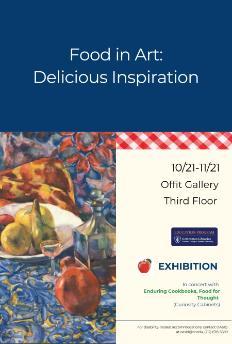New Exhibit: Food In Art, Delicious Inspiration
Offit Gallery
There are a whole lot of things in this world of ours you haven't started wondering about yet.
--Roald Dahl, James and the Giant Peach
Food in art inspires us to think about its various contexts and meanings. It may be the subject of art, including the teaching of art, with still life allowing students to practice their skills and also appreciate beauty in the simple physical entities that are consumed for nourishment or sustenance. Fruit, fish, grain, animals, and other types of food may also mark a social occasion through shared meals with family or friends at home or school. Agriculture, foundational to the food industry, may be affected by changes in government or politics – leading artists to reflect upon the health, or indeed socioeconomic status, of their nation.
Food in Art, Delicious Inspiration showcases artworks from the historical collections of Teachers College, Columbia University to encourage thinking about the timeless topic of food, especially through the eyes of children. The exhibit features drawings and paintings from the early 1900s, including those from the United States, Caribbean, Europe, Middle East, Asia, and the former Soviet Union. The majority of works come from the Ziegfeld Collection of International Children’s Art, dating from 1955-1957 and first shown at The Hague, Netherlands. The exhibit also shows food portrayed by adults, with select artworks drawn from the Students of Arthur Wesley Dow Collection, as well as the Federico Castellon Memorial Print Collection.
Representative works from the Ziegfeld Collection show the place of food at home, in the school cafeteria, and in farming. Fish is a prevalent theme, represented by student artists from Japan, Belgium and Morocco; fish are a common symbol for Christianity, rebirth, fertility, the higher self, luck, change, feeling, and health, but also of hardship.
From Children's Art of India we feature social customs, including festive and religious offerings. Simple, fresh fruit is key to healthy well being or vitality, and can also symbolize abundance. The labor of food (carrying a sheave of wheat for the provision of food to children) is joyously expressed through the young artist’s choice of a bright landscape.
Artworks from the Passow Collection of Israeli Children's Peace Art showcase the importance of agriculture and livestock, as well as bread for the military and poor. Bread symbolizes aspects of human life, including culture, history, hunger, war, and peace. The vine and fig signify the independence of the peasant farmer who is freed from military oppression.
According to Soviet theory, the state farm was the highest and most fully socialist form of agricultural organization. During Tsarist Russia, also known as the Russian Empire, Russian economy was largely agrarian, with over 80% of the workforce employed in agriculture and the main food crops were wheat, barley, rye, oats, potatoes, millet, buckwheat, rice, and pulses. On display is State Farm Giant Plaza from the Ukrainian Children's Art Collection.
From the Federico Castellon Memorial Print Collection there are pieces depicting both live and dead fish in abstract contexts, as well as a detailed intaglio of mushrooms, also symbolic of the cyclical nature of life, death, and transformation. Intricate and surreal, the artworks reflect adult perspectives, including the unconscious.
From the Students of Arthur Wesley Dow Collection there are two still lifes, one in watercolor and the other, in charcoal. Dow’s seminal text, A Series of Exercises in Art Structure for the Use of Students and Teachers (1899), stressed the importance of line, mass, and color in creating harmony, as well as the careful distinction between Notan, an element of universal beauty, and light and shadow, a single fact of external nature.
Paired with these artworks are children’s books from the contemporary collection to tie together the relationships between stories and illustrations for children from complimentary cultures and perspectives.
This exhibit is supported by the continuing generosity of the Myers Foundations, and it builds upon Enduring Cookbooks, Food for Thought, on display in the adjoining Curiosity Cabinets, Third Floor Reading Room. Both exhibits are designed by Soeun Bae, Library Associate / Art and Design.
Where: Offit Gallery
When: October 21 - November 21

Poster Image: Still Life, by Kolgan Yuri, 1956, from the Ziegfeld Collection of International Children's Art, Courtesy of Teachers College, Columbia University.
Digital Capture of Food in Art: Delicious Inspiration is provided by the Digital Futures Institute, Teachers College, Columbia University. Requests for accommodations may be submitted via online support.

